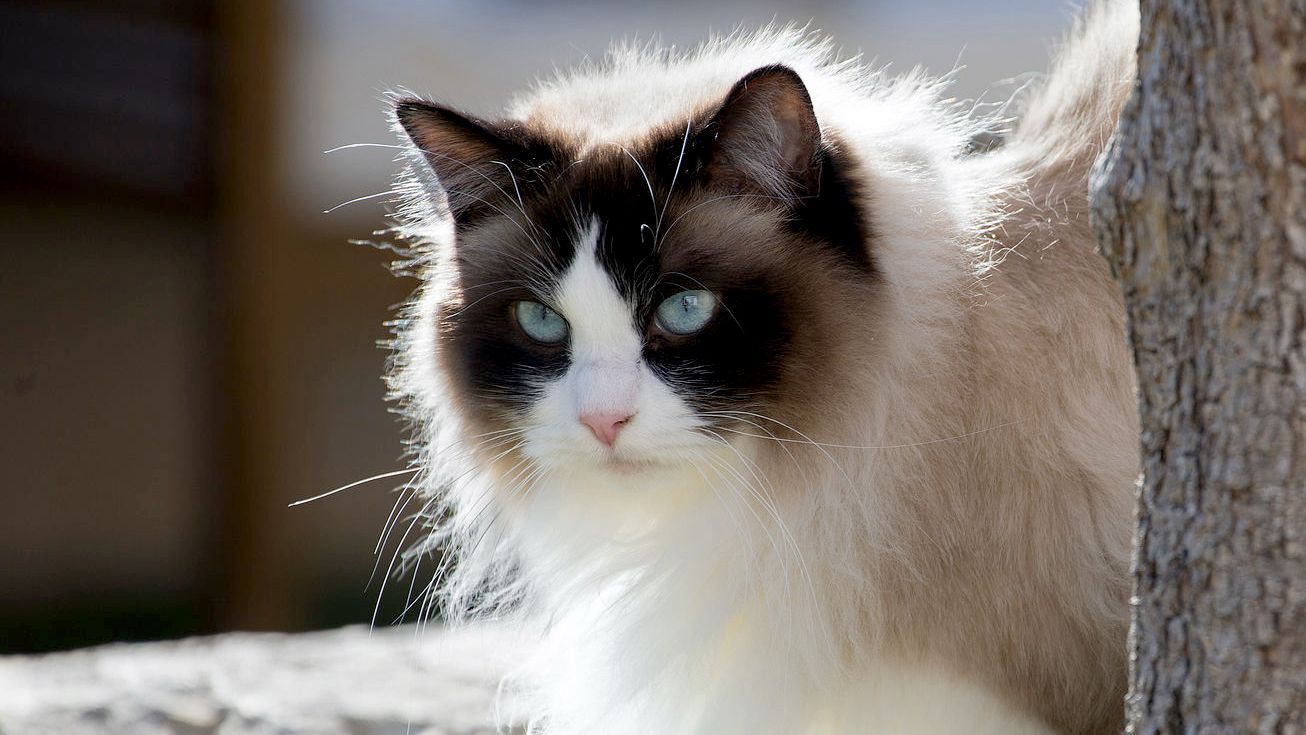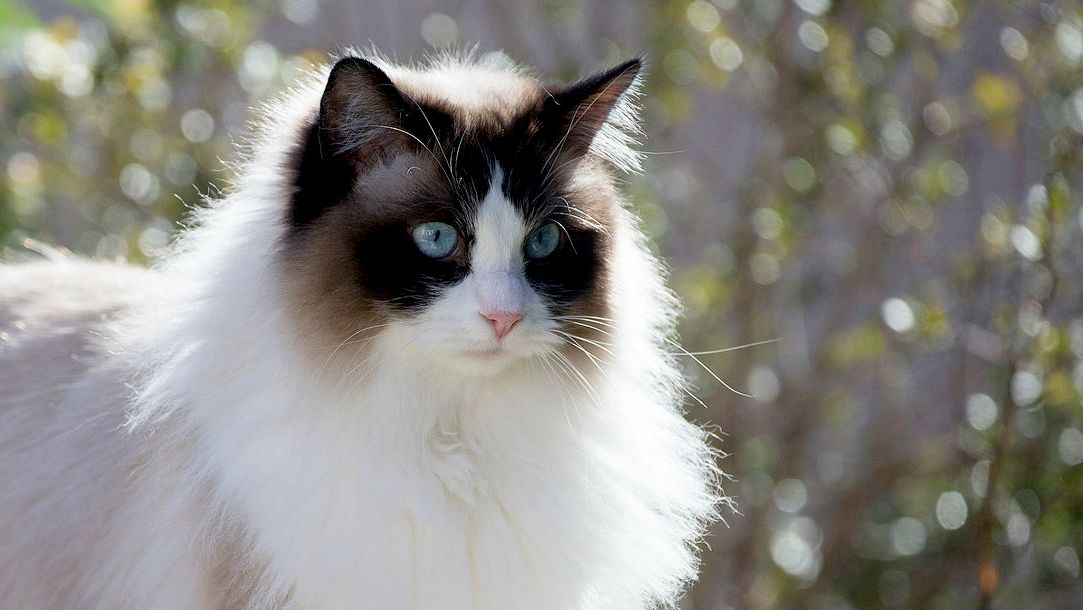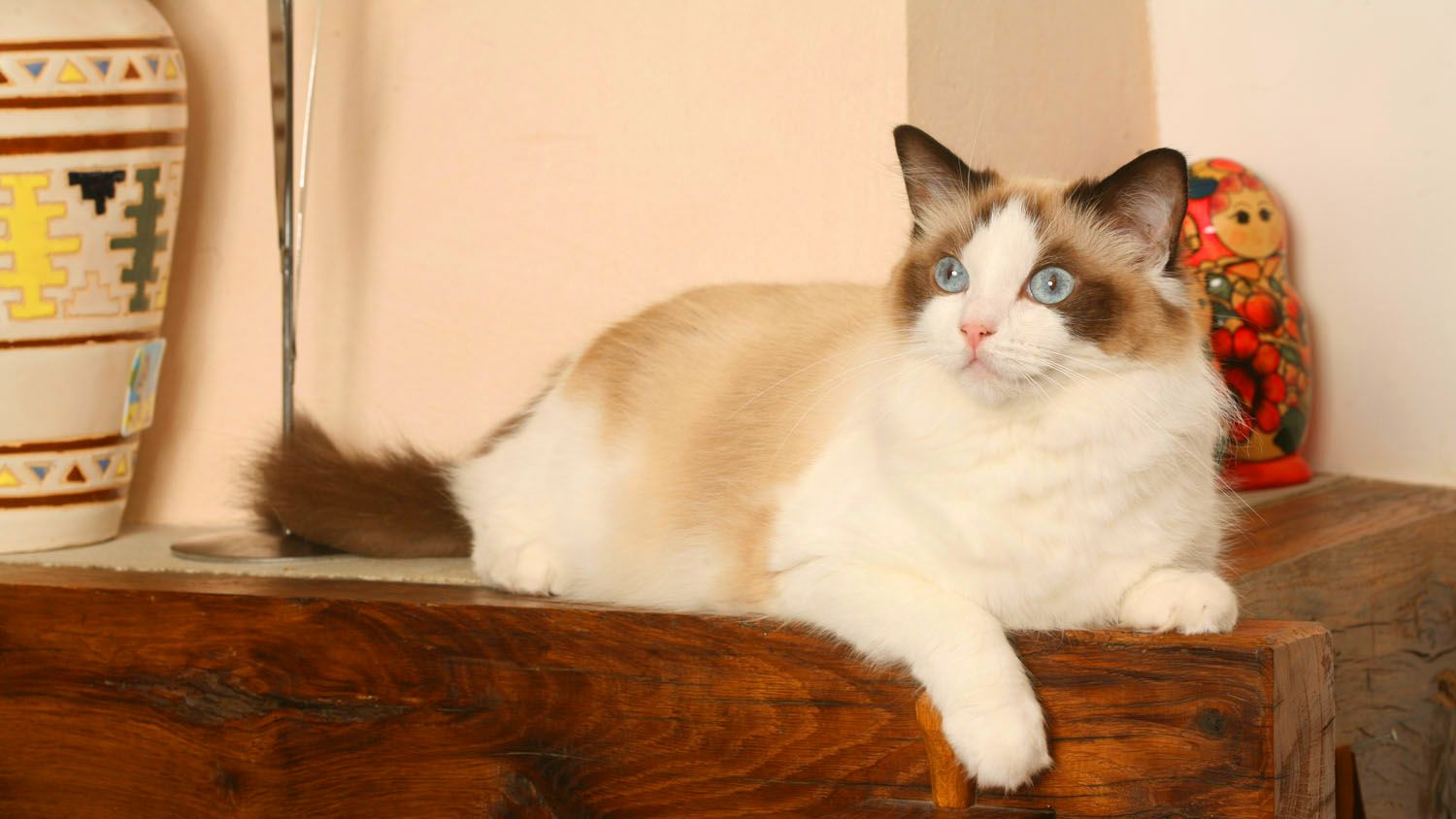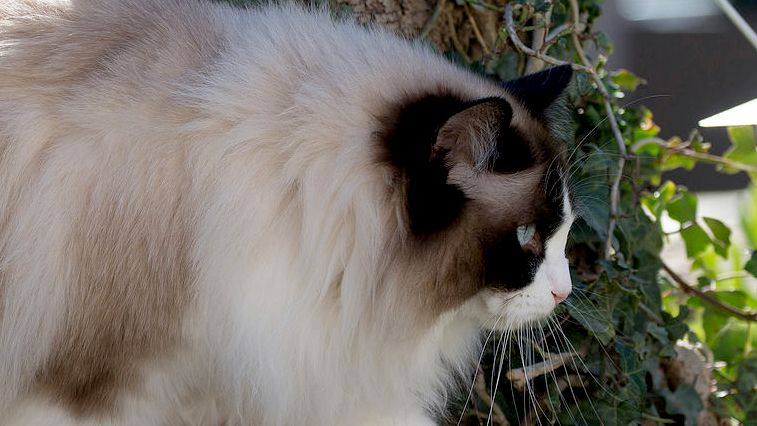Let's talk Ragdolls
Often cited as the world’s most popular cat, Ragdolls are the full package. As well as being an exceptionally beautiful breed, with their huge baby-blue eyes, luscious coats and velvety paws, they are also one of the largest, making them quite the head-turner. Very intelligent animals, Ragdolls are also easy-going, docile and sociable – and affectionate too. Even their name stems from them being so floppy and relaxed when picked up.
Official name: Ragdoll
Origins: USA
Hair length
3 out of 5Shedding Level
3 out of 5Grooming needs
2 out of 5Energy level*
3 out of 5Vocal
5 out of 5Family pet?*
4 out of 5Compatibility with other pets
5 out of 5Can be left alone
2 out of 5Environment (indoor/outdoor)
2 out of 5
| Male | Female |
|---|---|
| Height | Height |
| 23 - 28 cm | 23 - 28 cm |
| Weight | Weight |
| 5 - 9 lb | 4 - 6 lb |
| Life stages | |
|---|---|
| Kitten | Adult |
| 4 to 12 months | 12 months to 7 years |
| Mature | Senior |
| 7 years to 12 years | From 12 years |
Hair length
3 out of 5Shedding Level
3 out of 5Grooming needs
2 out of 5Energy level*
3 out of 5Vocal
5 out of 5Family pet?*
4 out of 5Compatibility with other pets
5 out of 5Can be left alone
2 out of 5Environment (indoor/outdoor)
2 out of 5
| Male | Female |
|---|---|
| Height | Height |
| 23 - 28 cm | 23 - 28 cm |
| Weight | Weight |
| 5 - 9 lb | 4 - 6 lb |
| Life stages | |
|---|---|
| Kitten | Adult |
| 4 to 12 months | 12 months to 7 years |
| Mature | Senior |
| 7 years to 12 years | From 12 years |

Get to know the Ragdoll
All you need to know about the breed
With beauty, brains, and a laid-back, affable personality, the Ragdoll is a cat that really does seem to have it all. They even have a good lifespan, often living well into their late teens.
And yet, as a breed, they have not been around for very long at all. Only developed in the 1960s in the United States, the Ragdoll is a relatively new addition to the feline world. In that short time, however, they have become one of the world's most popular cats.
One of the largest domesticated cat breeds, the female can reach up to 6lb and the male up to 9lb. Despite the Ragdoll cat’s statuesque size, however, they are not an especially energetic breed, and even quite quiet, so they usually fit in fine to most home set-ups. They are also known for their tolerant attitude towards children and other animals.
Their fluffy ‘plush’ coat - and the undercoat beneath - can make them seem even bigger than they are. Very varied in pattern, the Ragdoll cat colors can range from chocolate, lilac, and cream to seal, blue, and red. However, as a pointed breed, the common theme is that they usually have darker markings on their extremities.

Two facts about Ragdolls
1. Puss in boots
Among the many variations of color in the Ragdoll cat breed, one of them results in the cat having four white feet. So distinctive is the effect that animals with these markings even have their own name: the Mitted Ragdoll.
2. Dog in cat's clothing
Often described as more dog-like in their personality, Ragdoll cats exhibit a number of behavioral traits that are more commonly associated with canines. As well as enjoying a game of fetch, they will often follow you from room to room and will even greet you at the front door when you return home.
History of the breed
Hailing from California, renowned for its relaxed and laid-back lifestyle, it’s perhaps no wonder that the Ragdoll cat has such a carefree approach to life. It all began back in the 1960s when a local breeder called Ann Baker decided to cross her white, long-haired domestic, Josephine, with a seal point male (thought to have been a Birman cross), and also a solid black cat. Interestingly, the animals had all been strays previously.
Whatever the reason, the resulting offspring were so docile in their temperament that Ms. Baker decided to try and develop a breed. And because of the way they would go limp when they were picked up, due to being so comfortable with human contact, she decided to name this new variety the ‘Ragdoll’ cat.
Later, in the 1970s, other breeders - notably Denny and Laura Dayton - developed the breed further. Their aim was to formalize things and get the Ragdoll cat recognized officially. However, it wasn’t until the early 1990s that the Cat Fanciers Association (CFA) - the largest registry of pedigreed cats - began accepting the Ragdoll, eventually giving them full recognition in 1998.
The Ragdoll cat has certainly made up for lost time though. According to the CFA, they were the most popular breed in the world for 2020. That was also the second year in a row that they scooped the title of ‘Top Cat.'
From head to tail
Physical characteristics of the Ragdoll
1.Head
2.Coat
3.Coloring
4.Body
Body is large with medium legs and large round paws. Even though cats are known to be graceful creatures, Ragdolls can be clumsy.
5.Tail

Things to look out for
From specific breed traits to a general health overview, here are some interesting facts about your Ragdoll
It's important to keep a close eye on their weight
Due to their sizable stature, Ragdoll cats can sometimes experience problems with their joints and bones. Tell-tale symptoms of this are an abnormal gait, obvious limping, or more general signs of discomfort. The good news is that by feeding them a high-quality and well-balanced diet that supports healthy growth until they reach adulthood, and always making sure they are at a healthy weight, a lot of issues can be avoided. As always, stick to the guidelines on their food packaging and ensure they have enough daily activity. Also, no unhealthy snacks between meals!
They can be prone to mouth problems
Like many breeds, Ragdoll cats can also suffer with gum and dental issues. These tend to occur when plaque on the surface of the teeth is allowed to build up. This can induce an inflammatory reaction at gum level (gingivitis) – and, if it develops into tartar, this can result in an inflammation of the tooth’s support structures (periodontal disease). Symptoms can include red gums, pain, and bad breath – and, in severe cases, the resulting toxins can cause damage to the organs. As always, prevention is better than cure, so daily brushing and regular check-ups are key. Also, feeding your cat a special dental diet can certainly help. The action of the kibble rubbing against the teeth can help remove some of the plaque.
And they can be predisposed to a heart condition
Ragdoll cats are among the breeds genetically prone to something called ‘hypertrophic cardiomyopathy’. This is a heart condition that occurs independently of other cardiac or systemic disorders and causes a thickening in the walls of the ventricles. The impact on the normal cardiac function varies, but affected cats may develop problems ranging from exercise intolerance to a more serious prognosis. As always, forewarned is forearmed, so have a chat with your vet. A diagnosis can be reached using various techniques and a DNA test is also available. In addition, if you are thinking of getting a Ragdoll kitten, be sure to ask for the parents’ health certificates.
Tailored nutrition for Ragdolls

Tailored health nutrition has a fundamental role to play in maintaining the health and beauty of Ragdoll cats. Food provides energy to help with vital functions and a complete nutritional formula for Ragdolls should contain an adapted balance of nutrients. Feeding them in this way will offer a diet that's neither deficient nor excessive, both of which could have adverse effects on your cat's health.
Cats are naturally adapted to eating small servings - between 7 and 10 times a day.
The following recommendations are for healthy animals. If your cat has health problems, please consult your veterinarian who may recommend an exclusively veterinary diet.
Strong Immune System
Supports the development of the kitten's healthy immune system with the inclusion of clinically proven antioxidants, including vitamins E and C.
Healthy Growth
At 4 months old, a kitten's growth rate changes with rising energy levels to support growing bones and muscles. This formula contains an adapted level of protein, vitamins and minerals for the final stage of the Ragdoll's kittenhood until 1 year old.
Microbiome Support
Combination of prebiotics and highly digestible proteins to help promote a healthy balance of intestinal microbiota for digestive health.

The main nutritional goals for adult Ragdolls are:
Healthy Skin & Coat
The soft, silky, semi-longhaired coat is one of the Ragdoll cat's nicest features. A combination of specific nutrients including amino acids, vitamins, omega-3 and omega-6 fatty acids help maintain healthy skin and nourish the coat.
Cardiac Health
Contains nutrients such as taurine, EPA, and DHA to help maintain healthy cardiac function.
Bone & Joint Health
The Ragdoll's large size can put strain on their joints. Formulated to support healthy bones and joints. Contains EPA and DHA.
Special Ragdoll Jaw
This specially designed pyramid-shaped kibble is adapted to the Ragdoll cat's broad jaw. The unique kibble is easy to grasp and encourages chewing to help support oral hygiene.

A senior Ragdoll cat - one over the age of 12 - may sometimes have difficulties with absorption. To maintain the weight of the aging cat and minimize the risk of deficiency, they should be given an extremely digestible food filled with essential nutrients.
Weight Maintenance
In some senior cats, the level of activity reduces with age, which leads to weight gain. Aging Spayed/Neutered 12+ contains a moderate level of fat to help maintain an ideal body condition.
Healthy Aging Complex
An exclusive complex of antioxidants including lycopene and omega-3 fatty acids to support the body systems through the aging process.
Renal Health
Helps support healthy renal function with a moderate phosphorus level.
Enriched with L-Carnitine
L-carnitine is involved in healthy fat metabolism.

Caring for your Ragdoll
Grooming, training and exercise tips
When it comes to exercise, it’s important to get the balance right with Ragdoll cats. On the one hand, their large size means they do need to have a moderate amount of daily activity and also to keep their weight in check. On the other, Ragdolls aren’t the most agile animals and can be a bit uncoordinated at times. So, if you decide to invest in a cat tree, for example, it’s important to go for one that has wide steps and is not too high. Providing plenty of opportunities for active play at ground level is generally the best way to keep them in shape. One other thing to bear in mind with the Ragdoll cat is that it can be hard to spot an expanding waistline under their thick coat, so you may wish to pop them on the scales from time to time.
It may come as a surprise that Ragdoll cats don’t reach their full size and coat development until they are around 12 to 15 months of age. When they do, the adult Ragdoll cat has fur that is luscious and thick with a silky texture that is sometimes compared to that of a rabbit. As they have little undercoat, this means they are less prone to matting, but they still need brushing or combing at least once or twice a week to get rid of any dead hair. This is especially important during the Ragdoll cat’s shedding season. Ears should be checked regularly, nails clipped as needed and teeth brushed daily if you can manage it.
Given the breed’s gentle nature, Ragdoll kittens will always respond best to positive reinforcement. Highly intelligent animals, they will soon get the hang of the litter tray and scratching post, etc. Also, depending on the personality of your Ragdoll cat, some can even learn how to play games such as fetch. They are also a good choice of cat if you happen to have other animals, as they usually get along fine with other household pets. However, their trusting nature means they should be introduced with extra care to any existing cats or dogs, who might not welcome a stranger on their territory. For that same reason, and also because they can have a slight tendency towards clumsiness, owners sometimes choose to keep Ragdoll cats indoors.
When it comes to exercise, it’s important to get the balance right with Ragdoll cats. On the one hand, their large size means they do need to have a moderate amount of daily activity and also to keep their weight in check. On the other, Ragdolls aren’t the most agile animals and can be a bit uncoordinated at times. So, if you decide to invest in a cat tree, for example, it’s important to go for one that has wide steps and is not too high. Providing plenty of opportunities for active play at ground level is generally the best way to keep them in shape. One other thing to bear in mind with the Ragdoll cat is that it can be hard to spot an expanding waistline under their thick coat, so you may wish to pop them on the scales from time to time.
It may come as a surprise that Ragdoll cats don’t reach their full size and coat development until they are around 12 to 15 months of age. When they do, the adult Ragdoll cat has fur that is luscious and thick with a silky texture that is sometimes compared to that of a rabbit. As they have little undercoat, this means they are less prone to matting, but they still need brushing or combing at least once or twice a week to get rid of any dead hair. This is especially important during the Ragdoll cat’s shedding season. Ears should be checked regularly, nails clipped as needed and teeth brushed daily if you can manage it.
Given the breed’s gentle nature, Ragdoll kittens will always respond best to positive reinforcement. Highly intelligent animals, they will soon get the hang of the litter tray and scratching post, etc. Also, depending on the personality of your Ragdoll cat, some can even learn how to play games such as fetch. They are also a good choice of cat if you happen to have other animals, as they usually get along fine with other household pets. However, their trusting nature means they should be introduced with extra care to any existing cats or dogs, who might not welcome a stranger on their territory. For that same reason, and also because they can have a slight tendency towards clumsiness, owners sometimes choose to keep Ragdoll cats indoors.
7/7
All about Ragdolls
They become adults between 13 to 15 months of age and the normal life expectancy is 12 to 17 years. However, with the right diet and good veterinary care, they can sometimes live well beyond that.
Just the one, but the Ragdoll cat colors are very varied – ranging from red, seal and chocolate to blue, lilac and cream. Another fun Ragdoll cat fact, is that ‘seal point’ is the most popular coloring. There are also various different patterns, too. But just one breed of cat.
Other breeds that might interest you
Read more on this topic
Sources
- Vet Street http://www.vetstreet.com/cats/ragdoll
- Simply Cat Breeds http://simplycatbreeds.org/Ragdoll.html
- Purrcraze.com https://purrcraze.com/are-ragdoll-cats-very-vocal
- Purrcraze.com https://purrcraze.com/can-ragdoll-cats-be-left-alone
Like & share this page